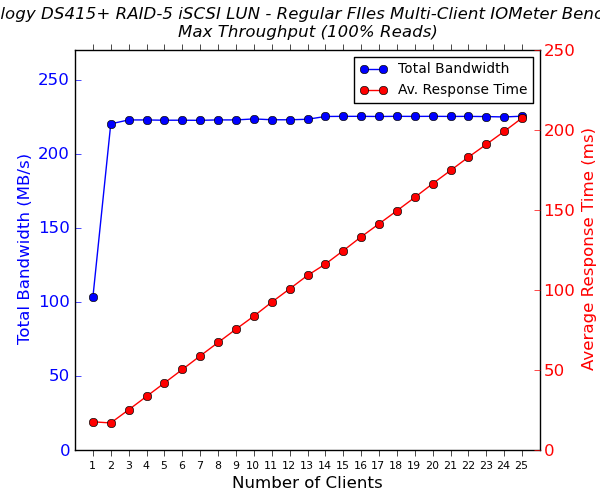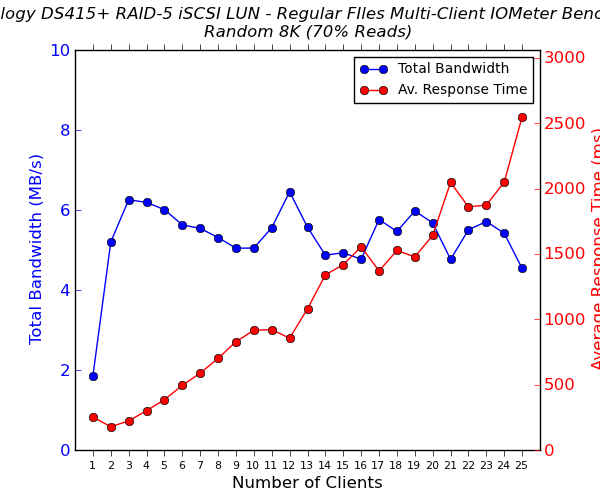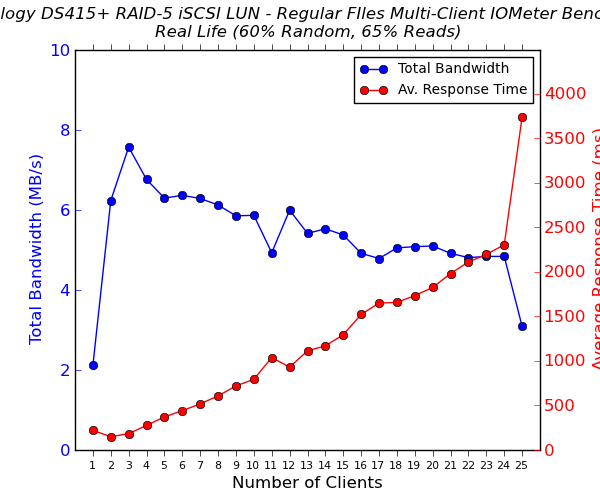Synology DS415+ Review: DSM on Intel Rangeley
by Ganesh T S on October 30, 2014 7:30 AM EST- Posted in
- NAS
- Storage
- Intel
- Synology
- Silvermont
- Enterprise
- Rangeley
Multi-Client iSCSI Evaluation
As virtualization becomes more and more popular even in home / power user settings, the importance of the iSCSI feature set of any COTS NAS can't be overstated. Starting with our ioSafe 1513+ review, we have started devoting a separate section (in the reviews of NAS units targeting SMBs and SMEs) to the evaluation of iSCSI performance. Since we have already looked at the way iSCSI LUNs are implemented in DSM in the ioSafe 1513+ review, it won't be discussed in detail.
We evaluated the performance of the DS415+ with file-based LUNs as well as configuring a RAID-5 disk group with a single LUN. The standard IOMeter benchmarks that we used for multi-client CIFS evaluation were utilized for iSCSI evaluation also. The main difference to note is that the CIFS evaluation was performed on a mounted network share, while the iSCSI evaluation was done on a 'clean physical disk' (from the viewpoint of the virtual machine).
Performance Numbers
The four IOMeter traces were run on the physical disk manifested by mapping the iSCSI target on each VM. The benchmarking started with one VM accessing the NAS. The number of VMs simultaneously playing out the trace was incremented one by one till we had all 25 VMs in the fray. Detailed listings of the IOMeter benchmark numbers (including IOPS and maximum response times) for each configuration are linked below:
- Synology DS415+ - iSCSI LUN (Regular Files) - 4x 4 TB / RAID-5 / 2x 1G
- Synology DS415+ - Single LUN on RAID - 4x 4 TB / RAID-5 / 2x 1G




Since the number of NAS units that we have put through this evaluation is limited, the only real point of comparison is the Seagate NAS Pro 4-bay. The ioSafe 1513+ graphs are also linked above, but it has five drives instead of the four in the DS415+. The only graphs for apples-to-apples comparison are those of the Seagate NAS Pro 4-bay units. We see advantages in terms of average access times for the Synology DS415+. This is only to be expected, given the faster clock for the Rangeley SoC in the DS415+.
As more NAS units are processed, we hope this section will provide readers with a way to quickly get an idea of the competitive performance of a particular NAS unit when it comes to iSCSI support.










41 Comments
View All Comments
stbufraba - Sunday, November 2, 2014 - link
Did anyone try DDR3L memory modules in the DS415+?